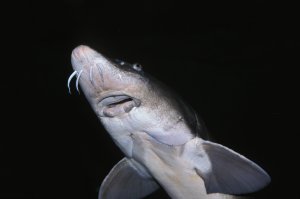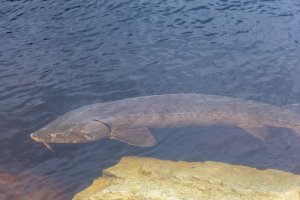Living Fossils: Lake Sturgeon
A living fossil making a Great Lakes comeback, September 28, 2022
Imagine a fish that reaches lengths of almost seven feet and a weight of nearly 200 pounds. Instead of scales, this fish is covered with hard plates of armor-like skin. Females of this species have been recorded at 150 years old! The fish we’re imaging is alive and making a slow comeback in the Great Lakes region where it was once abundant.
If you imagined the Lake Sturgeon (Acipenser fulvescens) you were right! Though seldom seen, these migratory fish are traditionally found throughout the Great Lakes. While this may be our largest freshwater fish, it isn’t exactly a predator that most people and animals need to be concerned about. These living fossils, which have been around for more than 100 million years and today make up 29 living species, primarily eat tiny crustaceans, clams, snails, and other small invertebrates. Changes to the Great Lakes ecosystem, including the explosive spread of non-native species such as zebra and quagga mussels have had an outsized impact on these giant fish.

Along with invasive species, a combination of factors led to a longtime decline in the Lake Sturgeon population: overharvesting of these fish for food in the 1800s and early 1900s and sedimentation due to human changes to our rivers of the rocky shoals they use for spawning are two important pieces of the sturgeon story. Sturgeon are long-lived, but it takes them a long time to reach reproductive age and they don’t spawn every year. Most Lake Sturgeon don’t begin spawning until they reach between 15-25 years old and they need hard, rocky substrate for spawning. When we channelize or dredge waterways for navigation, it can allow sediments to settle on the rocky bottom, preventing sturgeon from spawning or burying the eggs and preventing them from hatching.

Recovery of Lake Sturgeon in the Great Lakes takes many forms. The creation of artificial reefs for spawning, the rearing and release of juvenile sturgeon, the deployment of acoustic tagging to monitoring sturgeon migration, and even Sturgeon festivals that help connect the public to the plight of these fish in the Great Lakes are all opportunities to support a successful sturgeon recovery.
Programs such as Sturgeon in the Classroom, supported in partnership between Sturgeon for Tomorrow chapters and the Michigan Department of Natural Resources, help to get juvenile sturgeon into classrooms and nature centers where people of all ages can observe and enjoy these ‘fossil’ fish. At the end of the academic year, the juvenile fish are large enough to release, adding new fish into the population and new sturgeon fans into the public!
Lake St. Clair Metropark Nature Center is working with the St. Clair-Detroit Sturgeon for Tomorrow chapter to host a juvenile sturgeon starting in October of 2022. Or visit Lake Erie Metropark Marsh Museum and examine a life size sturgeon replica up close. Come visit and help us celebrate the recovery of these fossil fish!
